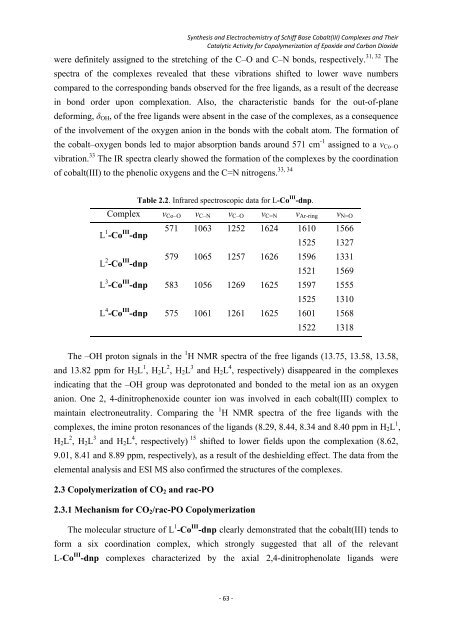Catalytic Synthesis and Characterization of Biodegradable ...
Catalytic Synthesis and Characterization of Biodegradable ...
Catalytic Synthesis and Characterization of Biodegradable ...
You also want an ePaper? Increase the reach of your titles
YUMPU automatically turns print PDFs into web optimized ePapers that Google loves.
<strong>Synthesis</strong> <strong>and</strong> Electrochemistry <strong>of</strong> Schiff Base Cobalt(III) Complexes <strong>and</strong> Their<br />
<strong>Catalytic</strong> Activity for Copolymerization <strong>of</strong> Epoxide <strong>and</strong> Carbon Dioxide<br />
were definitely assigned to the stretching <strong>of</strong> the C–O <strong>and</strong> C–N bonds, respectively. 31, 32 The<br />
spectra <strong>of</strong> the complexes revealed that these vibrations shifted to lower wave numbers<br />
compared to the corresponding b<strong>and</strong>s observed for the free lig<strong>and</strong>s, as a result <strong>of</strong> the decrease<br />
in bond order upon complexation. Also, the characteristic b<strong>and</strong>s for the out-<strong>of</strong>-plane<br />
deforming, δOH, <strong>of</strong> the free lig<strong>and</strong>s were absent in the case <strong>of</strong> the complexes, as a consequence<br />
<strong>of</strong> the involvement <strong>of</strong> the oxygen anion in the bonds with the cobalt atom. The formation <strong>of</strong><br />
the cobalt–oxygen bonds led to major absorption b<strong>and</strong>s around 571 cm -1 assigned to a vCo–O<br />
vibration. 33 The IR spectra clearly showed the formation <strong>of</strong> the complexes by the coordination<br />
33, 34<br />
<strong>of</strong> cobalt(III) to the phenolic oxygens <strong>and</strong> the C=N nitrogens.<br />
Table 2.2. Infrared spectroscopic data for L-Co III -dnp.<br />
Complex vCo–O vC–N vC–O vC=N vAr-ring vN=O<br />
L 1 -Co III -dnp<br />
L 2 -Co III -dnp<br />
571 1063 1252 1624 1610 1566<br />
1525 1327<br />
579 1065 1257 1626 1596 1331<br />
1521 1569<br />
L 3 -Co III -dnp 583 1056 1269 1625 1597 1555<br />
1525 1310<br />
L 4 -Co III -dnp 575 1061 1261 1625 1601 1568<br />
1522 1318<br />
The –OH proton signals in the 1 H NMR spectra <strong>of</strong> the free lig<strong>and</strong>s (13.75, 13.58, 13.58,<br />
<strong>and</strong> 13.82 ppm for H2L 1 , H2L 2 , H2L 3 <strong>and</strong> H2L 4 , respectively) disappeared in the complexes<br />
indicating that the –OH group was deprotonated <strong>and</strong> bonded to the metal ion as an oxygen<br />
anion. One 2, 4-dinitrophenoxide counter ion was involved in each cobalt(III) complex to<br />
maintain electroneutrality. Comparing the 1 H NMR spectra <strong>of</strong> the free lig<strong>and</strong>s with the<br />
complexes, the imine proton resonances <strong>of</strong> the lig<strong>and</strong>s (8.29, 8.44, 8.34 <strong>and</strong> 8.40 ppm in H2L 1 ,<br />
H2L 2 , H2L 3 <strong>and</strong> H2L 4 , respectively) 15 shifted to lower fields upon the complexation (8.62,<br />
9.01, 8.41 <strong>and</strong> 8.89 ppm, respectively), as a result <strong>of</strong> the deshielding effect. The data from the<br />
elemental analysis <strong>and</strong> ESI MS also confirmed the structures <strong>of</strong> the complexes.<br />
2.3 Copolymerization <strong>of</strong> CO2 <strong>and</strong> rac-PO<br />
2.3.1 Mechanism for CO2/rac-PO Copolymerization<br />
The molecular structure <strong>of</strong> L 1 -Co III -dnp clearly demonstrated that the cobalt(III) tends to<br />
form a six coordination complex, which strongly suggested that all <strong>of</strong> the relevant<br />
L-Co III -dnp complexes characterized by the axial 2,4-dinitrophenolate lig<strong>and</strong>s were<br />
‐ 63 ‐

















